
CHEERS!
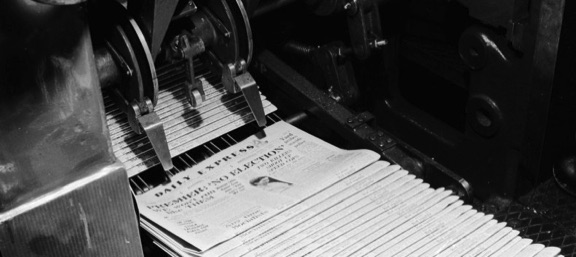

1882 NEWS ARTICLE PROVIDES INFO ABOUT DARRTOWN'S PAST
An 1882 news article, along with two accompanying photographs, appeared as a REPRINT, in the August 23, 1976 edition of the Oxford Press (Vol. 1, No. 23). The article is replicated below.
...one thing from this 1882 news article stands out...

THE 1882 NEWS ITEM proves that the long-time, locally-told story is TRUE!
The 1882 news story (replicated below) included this preface: "The following random notes on the Darrtown community were compiled from information in the Butler County History of 1882, as well as from material supplied by William M. Ramsey and R. Kirk Mee, the latter also supplying the photographs."
"Darrtown of Days Gone By
In 1802, Conrad Darr and Robert and William Ogle (neither thought to be related to Harry Ogle, a present Darrtown resident ) entered claims for Section 28, on which the community now stands and, after making entry, returned to their families in Pennsylvania. A year later, the year of Ohio's statehood, John Douglass entered claim for one mile square for which he, like the others, paid $1.25 per acre.
In the Spring of 1804, the families of Douglass, Darr, and the Ogles left their homes in the "Hickory Shad" section of the Schuylkill River and came westward to Butler County, which had just recently been formed from part of Hamilton County. Douglass settled to the northwest of what is now the Route 73 and Route 177 intersection, on part of what was to become the Joseph Davis farm that lends its name to 'Davis Corner.'
The Douglass cabin is thought to have been located on the bank of the run which crosses Route 177 near the Hansel farm.
Robert Ogle's claim took the northeast quarter of the section; William Ogle took the northwest quarter, and Conrad Darr look the south half, where in 1814 he laid out the village of 'Darrtown.'
Abraham Darr is said to have been the first resident of the village and maintained a store near the center of town until the building burned about 1820.
Conrad Darr's cabin is said to have been located in the vicinity [TEXT MISSING…TO BE RESEARCHED AT THE LANE LIBRARY] …and in 1815 Conrad Darr began a tanyard in the northern portion of the village.
Abraham Darr built a frame house on the west side of the pike about 1817 and began in the tavern business, in the early 1820's. By 1832, he was also operating a stillhouse to the north.
The tavern was later operated as a storeroom by Patterson and Martin, and in the latter part of the nineteenth-century it was a saloon operated by Phil Zimmerman.
During prohibition, the room was used as a grocery, operated by Lou and Anne Shuck, and then was enlarged and remodeled for a store and poolroom run by Oscar Irvin and later by Stanley Alston and William Wiley, as well as by Bob Zimmerman.
About 1936, George Lentz again converted the space to use as a tavern, selling it in 1944 to Earl "Red" Huber, whose present "Hitching Post" thus dates back more than 150 years.
***************
Early Darrtown citizens included Willis Davis, a saddler; Herron and Genton, tailors; John Cook, Stephen Cook, Henry Branner, and Henry Krigger, all blacksmiths; Aaron Chamberlain, wagon-maker; John Mills built a carding mill in 1822, selling out to Abraham Darr, who used the machinery in his stillhouse, the power supplied by a large treadmill turned by oxen. James Broadberry (Bradbury) had a saw and grist mill below Darrtown as early as 1818; at one of the mills, the one which provided lumber for the Union Church of 1826, lumber was cut on an "Up and Down Mill," the saw being an enlarged version of a cross-but saw, held in an iron frame, which enabled it to push forward and then drag on the back-stroke.
Mitchell Marshall had a large three-story stillhouse east of Darrtown from 1845-52, and in 1816 Wallace and Bryant erected a saw-mill, grist mill and fulling mill, all run by undershot wheels, on Four Mile Creek, west of Darrtown. Bryant was the fuller and Wallace did sawing and grinding for eight or ten years, selling out to James Smiley. A three-story stone mill building (still standing) was erected in l850 and later operated by Smiley's son-in-law, W. L. Lane. Griffith's mill and the mill and distillery of Thomas Cooch were located along the Four Mile Creek, between Lane's Mill and [TEXT MISSING…NEEDS FURTHER RESEARCH...]
William Kirkpatrick had a tavern in the center of Darrtown, on the east side of the park, prior to 1845, and following his death in 1848, his widow, Mary Magdalene Flenner Kirkpatrick married David Mee. Their son, John F. Mee, was born in 1852, ten years after his step-brother, Samuel Kirkpatrick, who later ran the tavern. The tavern building is still standing, immediately south of the southeast quadrant of the village square. It is now (2014) a private residence.
David Mee had come from Wales and settled first in Pennsylvania. Following his death, his widow, known as "Polly," was married a third time, to John Cooch.
For a time, John F. Mee and his wife, Mary Emaline Teague Mee, lived in the Samuel Kirkpatrick tavern and house, and then, in 1895, bought the old Teegarden property at the north edge of the village.
The John Mee's remodeled the old farmhouse considerably, adding a number of Victorian touches to the structure, and in the late 1920's, much stone work was added by Fritz Schmidt, for the Mee 's son, R. Kirk Mee I and his wife, Helen (Hickernell) Mee.
Colonel Mee I was an extremely active Democratic leader in the county and state and his gracious wife was an outstanding musician; they entertained extensively at "Linn Place," their guests including Franklin Delano Roosevelt, then Secretary of the Navy, and Ohio Governors Vic Donahey and George White.
After Mr. Mee's death in 1948, his son Kirk Mee II, and family occupied the house, until it was sold in 1969.
***************
On July 6, 1907, a cyclone hit Darrtown and demolished the Methodist Church and the schoolhouse. Both were condemned and required extensive rebuilding. School was held temporarily in the old I.O.O.F. Hall. In the storm, the roof also collapsed on the McVicker property, which had been the old Kirkpatrick tavern. The K of P lodge had met in the upstairs area of this building, prior to constructing the lodge hall on the village square in 1904. The lodge was organized in Darrtown, in 1892.
The old Union Church, a frame structure built in 1826 on what is now Apple Street, east of Cherry, was later used as a town hall and collapsed and was destroyed in high winds of August, 1928.
***************
As early as 1835, Oxford citizens were proposing a railroad to Cincinnati, by way of Hamilton and on March 12, 1849, the Four Mile Valley Railroad was incorporated and officially organized in 1851, with Peter P. Bailey of Ft. Wayne, Ind., as President, and S. H. Mollyneaux, of Oxford, as Secretary and Treasurer.
Two years later, the Four Mile Valley merged with the Cincinnati-Ft. Wayne Railroad, and with more than $450,000 subscribed, the Directors recommended that work be started at once. Grading with picks, shovels, scoops, wheelbarrows, and horse carts was begun south of Fairhaven, east of Oxford, and southeast of Darrtown, where remnants of the level-bed levee can still be seen running almost parallel to Route 177, just east of the highway at the south end of Darrtown. But, the Four MIle Valley railroad died from a lack of funds and an abundance of stiff competition.
***************
Between Route 177 and the old railroad levee south of Darrtown, there was, in the early part of this century, a ball field which gave rise to one of the hottest teams in the state, perhaps presaging Darrtown's subsequent claim to fame as "Baseball Capital," the hometown and residence of Walter "Smokey" Alston, longtime and highly successful Manager of the Brooklyn and Los Angeles Dodgers.
Just after World War I, the Darrtown nine claimed to be "the best in the county," a point strongly contended by Hoovens of Hamilton, who challenged the Darrtown locals to a three-game series.
In the first game, Stanley "Doc" Aiston, Smokey 's uncle, pitched and the score was 2-2, until late innings, when Alston was taken out and Tody Landis finished. Hoovens got to him and won,10-2.
So keen was the rivalry, that, in those days before organized clubs and lengthy contracts, "pro's" could be called upon to "pinch hit" (which meant, not merely a substitute, but a superior player to bring in "in a pinch").
In the second game of the series, Hod Eller, '"shine ball" pitcher for the Cincinnati Reds, pitched for Darrtown against Charlie Root, of the Chicago Cubs, for Hoovens and Darrtown won, 1-0.
In the fever-pitch final game of the series, "Legs" Wielman of the St. Louis Browns came in to pitch for Hoovens and they won the game. 13-3. There "was no joy in Mudville," but these games drew over 3,000 paid admissions each and many more viewers sneaked onto the Darrtown field, from across the railroad levee to the east.
Butch Shaffer managed the Darrtown outfit and the players included:
"Doc" Alston, pitcher; Kay Smear, outfield; Matt Foy, catcher; Fritz Erlewein, second base; Cliff Sheard, shortstop; Dewey Wynn, first base; Rudy Landerman, third base; Waldo Stumpf, outfield, Oscar Vitt, outfield
=========== END OF ARTICLE ===========
The following photographs and captions were part of the 1882 news story.
ABOVE:
DARRTOWN CORNET BAND...
- PARADING PAST THE SKATING RINK,
ON DARRTOWN'S MAIN STREET
"The Darrtown Cornet Band is shown parading south on the Richmond Pike, circa 1900.
The "Hitching Post" site is behind the horse and buggy at the left.
The building at the right was constructed for a skating rink.
The sign above the porch advertises Martin Mason Lager Beer.
The Darrtown Band was organized prior to 1895 and practiced in Frank Bufler's hall and later used the K. of P. hall built in 1904."
Webmaster Note: From the info above, it seems that this photo was taken looking north, with the Hitching Post at the left (and west side of Main street).
ABOVE:
POPST HOTEL…
- THAT LATER BECAME… A POOL ROOM, IMPLEMENT STORE, AND AUTO GARAGE
"The same skating rink building (noted in the caption above) a few years later, when Jacob Popst was operating it as a saloon and hotel.
In the picture, the Atens, Blairs, and McKees are about to embark on a camping trip, circa 1904.
When the town went dry, Lee Glardon ran a pool room in the Popst building; then Arthur Dodd and Sam Cochran had an implement store there.
It stood vacant, until Jesse Francis started a garage there in 1921. He was in business, until it was destroyed by fire, in 1933.
Earl "Red" Huber now has a storage building on this site."
Webmaster Note: From the info in the article above above, it seems that this photo was taken looking south, with the Popst Hotel at the left (and eas)t side of Main Street.
The reprinted 1882 news article primarily reinforces or embellishes stories previously acknowledged at this website.
For many years, throughout the Darrtown community, older generations told younger generations that, "back in the day," a railroad had been planned for Darrtown.
The 1882 news article is the FIRST published item (contributed to this website) that verifies the plan to fund the construction of a railroad that would run through Darrtown.
This 1882 news article is historically significant to Darrtown history, because IT SUBSTANTIATES ORAL HISTORY!
Webmaster Note: The 1882 newsclipping about the parade down Darrtown's main street refers to a sign on the skating rink building that advertises Martin Mason Lager Beer.
The Martin Mason brewery in Hamilton, Ohio is seen in the image at the right (which appeared on Facebook in February, 2021).
Judging by the cars in the photo, it seems the shot was taken in the 1950s.

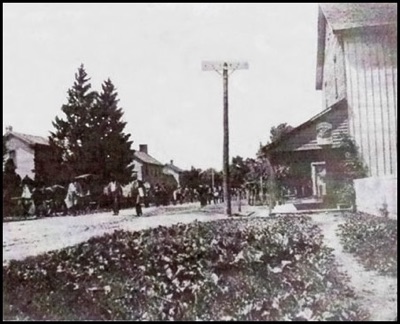
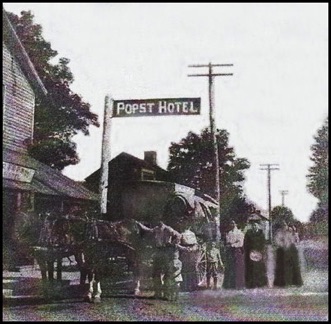
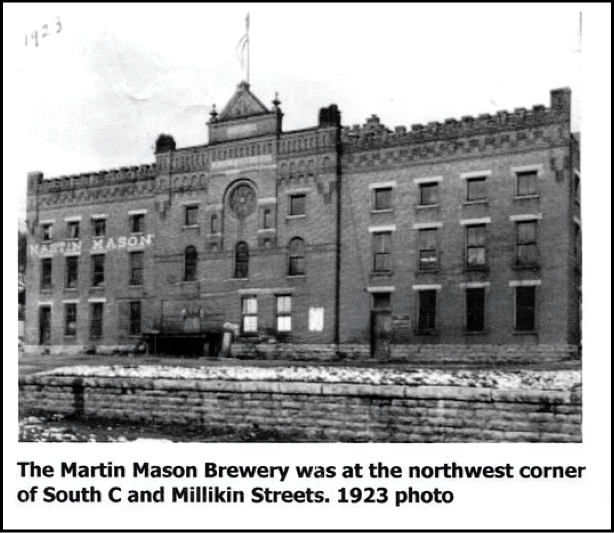
The 1923 image at the right appears in a 2016 news article, written by Jim Blount, about the brewery business in Hamilton, Ohio.
To access the Jim Blount article, see: After 75-year drought, beer production resumes in Hamilton
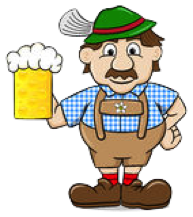
JA, it is true that this story about the Martin Mason brewery is more of a Hamilton story than a Darrtown story, but, remember that the Germans love their beer and many early Darrtown residents were of German descent, so...

Links to items in the following 1882 news story reprint:

